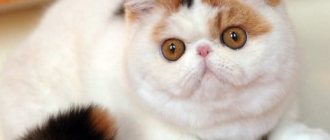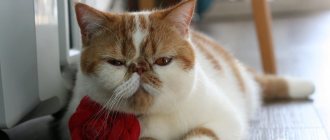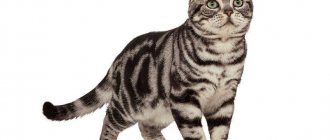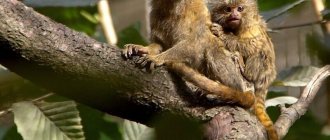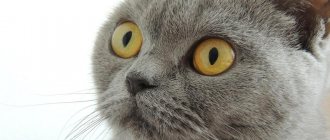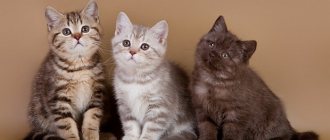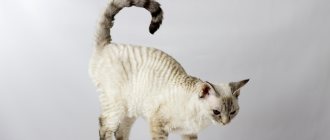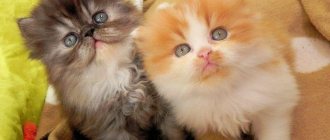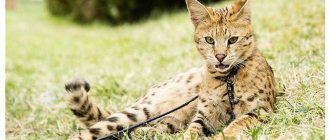Exotic Shorthairs are compact, attractive cats with plush fur, a flattened nose and huge, expressive eyes. Thanks to their charming appearance and friendly disposition, they are the object of dreams for adults and little animal lovers. But in order for communication with an exotic to bring only joy, before buying an exotic, you should study the main characteristics of the breed.
Description of the exotic cat breed
Popularity 11th place among 87 cat breeds
Lifespan:
12-15 years
Height:
up to 30 cm
Country of origin:
USA
Average price:
20-30 thousand rubles
Weight:
3-6.5 kg
Latest articles Cat health
Ataxia in cats: what it is, how it manifests itself and is treated 01/23/2022 151 0 0
Cat health
Leukemia, or viral leukemia in cats 01/23/2022 140 0 0
Key facts
The exotic shorthaired breed is quite young, but has already earned popularity all over the world. Indeed, exotics are considered a good purchase due to their upturned nose, round funny face and bottomless eyes. Because of the texture of their fur, they are very similar to soft plush toys.
The country of origin of these individuals was the United States of America. Another name for the breed is Exotic Shorthair, and its abbreviated name is Exotic. Overseas breeders, as a result of crossing local and Persian breeds, achieved the birth of an amazing creature. The description of the exotic cat says that, in addition to the unusual exterior, the cats are peaceful, friendly and calm, which makes these cats suitable for keeping in any family.
Characteristics of an exotic cat: developed intelligence, curiosity, and quick wits; all this helps animals easily learn hygiene rules and even simple commands. The disadvantage of the breed is that exotic pets are in great need of human attention, so in the absence of it they suffer greatly.
The average life expectancy of an exotic cat is 12-15 years; proper care will help extend the years of your pet's life.
Necessary purchases
- The tray should not be very large and without a grid so that the pet can dig the filler without experiencing obstacles.
- Among fillers, preference is given to compressed sawdust.
- Since exotic shorthairs have a playful character even as adults, you should stock up on toys. When choosing, pay attention to the absence of sharp and small parts that the cat can swallow.
- A scratching post is an important element that is necessary for the safety of furniture. To teach a kitten to sharpen its claws in one place, you can use special sprays.
Origin story of the exotic cat
The exotic breed appeared in the 50s of the last century, and it happened completely by accident. The fact is that American breeders sought to develop a new color for the American Shorthair cat, as well as to make its body denser. For these purposes, they crossed an American with a Persian individual.
American breeders were unable to achieve the desired result, but received cute, almost doll-like offspring. From fluffy Persians, the kittens received thick plush fur and an unusual appearance. This is how representatives of a new exotic shorthaired breed appeared.
It was under this name that breeder Jane Martink presented the animals at the exhibition in 1966. Unfortunately, they did not receive quick recognition. Many breeders not only treated this breed poorly, but also prevented their breeding. The exotic cat turned out to be persona non grata at some exhibitions. Some breeders refused to breed Persian cats with exotics. Only Doris Walkinstick and Caroline Bussey saw the prospect of new animals and took part in their selection.
To improve the external qualities of pets, representatives of the Burmese breed, as well as Russian blue cats, were used. It was they who helped to consolidate the gene responsible for short, dense hair. Subsequently, such matings were stopped, mating was carried out only with Persians.
In 1990, breeders decided that all deviations from the Persian breed standard, namely the length and quality of the coat, belong to the Exotic Shorthair standard. From that time on, a triumphal procession of exotics began around the world. In Russia, the popularity of the breed is quite high, which explains the large number of nurseries in our country.
Table: pros and cons of the breed
| pros | Minuses |
| Kind character, love affection and attention, relate well to small children, playful and unforgiving | Susceptible to a wide range of diseases |
| Have a cute appearance | Requires regular eye and ear hygiene |
| Exotics do not require complex grooming | The fur in the area of the flattened muzzle often gets dirty |
| Do not show aggression | The high cost of kittens |
Similar cat breeds
British shorthair cat
Persian cat
American shorthair cat
What does an exotic cat look like?
Even a child can tell what an exotic cat looks like, the breed is so popular. In the photo, the exotic cat looks like a plush toy, but its personality doesn't quite match its appearance.
Muzzle
The exotic head is powerful and round in shape. The skull has wide, strong bones. The chin is strongly developed and has a round shape. The cheeks are very dense and fleshy. The jaws are strong and wide.
The eyes are round and large in size. They are located on the same line, but quite far from each other. The eye color of Persian cats is usually copper, dark copper, orange or yellow; in chinchillas – green, emerald green; Blue eye color is found in white cats and is required for color-point cats. The nose, paw pads, and whiskers correspond to the main color.
The ears are small, neatly round in shape. They are located low and also slightly tilted forward.
The pet's nose is very wide, but short and strongly turned up. The lobe is located almost between the eyes.
Body type
The general impression of a soft toy that resembles an exotic animal is deceptive. In fact, cats have a massive body, strong and slightly heavy bones. The body size is medium-sized with a broad chest and massive shoulders. The body itself is squat, with strong muscles and almost no fat. Varieties of exotic cats are not distinguished by body type or face shape.
The front and hind limbs of the animal are short, with strong bones. When looking at the cat, you can see that they are standing straight, parallel to each other. The hocks of this handsome plush are large, round in shape. There are 5 toes on the front paws, and 4 on the hind paws.
The tail of exotics is shortened, without bends. When at rest, it is located below the back.
Coat and color
The fur of an exotic cat is thick, of medium length, with a dense undercoat. It feels very soft and plush to the touch.
Exotic cats have the greatest variety of colors compared to other breeds. There are many varieties of recognized exotic cat colors:
- solidas, or solid colors from white to black, also include lilac, chocolate or fawn;
- tortoiseshell cats with white spots;
- patterned colors such as tabby or merle;
- color points are seal point, blue point, red point, cream point;
- tipping colors - chinchillas (silver, golden, cameo), as well as shaded, veiled.
Various combinations of colors and patterns make choosing a pet very difficult.
Colors of exotics with photos
The breed has a lot of colors, as there can be different combinations of colors and tabbies. We will show some of them (see photos).
- Red tabby is a color with a bright red tint on the back and less pronounced on the belly.
- Marble is a color whose shades can be different (red with beige, gray with black), but the “pattern” has such “marble” lines. See photo
- Black color has no other shades.
- Blue is a gray-blue color.
- Tortoiseshell is a combination of colors.
- White color - the perfection of whiteness is striking in its purity.
- The red color has a delicate shade of beige (cream).
Conclusions about the breed
How to describe the character of this breed in a few words? Do you know the Persian cat? Not at all similar! An exotic cat is more active and smarter, more playful and peaceful.
If you could describe the breed's temperament in one word, that word would be serenity!
Breeders and simply owners of exotic shorthair cats note the special sociability of representatives of the breed. They will be equally happy to communicate with both the owner of the house and small children. Exotics, surrounded by their human flock, behave calmly both within the home and on long journeys. However, if you decide to teach an exotic cat a couple of tricks, then your attempts will be in vain - the intelligence of this breed is not adapted to human whims.
Like all artificially bred breeds, the exotic cat has a number of hereditary diseases:
- deformation of teeth and jaws;
- chronic sinus diseases;
- epiphora - increased lacrimation;
- hereditary kidney diseases.
Reviews from owners of exotic shorthair cats
Lyudmila : “It looks like a bun, but not a toy! There are all kinds of stories about this breed - and they allegedly have breathing problems due to the peculiar structure of their muzzle, and they are supposed to be allergenic, and constantly shed... Well, I don’t know. Our Sharfik has no such problems! I admit that we were just lucky with him. But not everything is so rosy - Sharfik’s character is not as soft as his plush fur coat.
He may scratch if he doesn’t like something, and he may also pointedly ignore it. At the same time, like all exotics, he is rather phlegmatic. The choleric person in him wakes up only at night! He doesn’t like children and excessive affection, but at the same time, Sharfik is very intelligent.”
Irina : “Our cat’s name is Boniface, or simply Bonya, and this cat is a joy. He is very sensitive to the general atmosphere in the family, he feels everyone’s mood. He doesn’t like to sit on our laps, but at the same time he touches us with his paw. He wakes him up in the morning and loves to play with tap water. Bonka is already 6 years old and during all this time he has not spoiled a single thing!
I noticed that my exotic cat is quite touchy. They cannot be called vengeful, but they know how to take offense very effectively. I advise kitten owners to pay special attention to nutrition, because our babies are prone to obesity.”
Stepan : “Exotic cats have always been in our family, so I can consider myself an expert on the breed. So, I recommend - fat people, but not simpletons! They are optimists, but not populists. The activity of exotics is average; they will not hang out on the curtains, but will intelligently play with the toy purchased for them.
They will never go into the arms of strangers for anything in life, but they love their flock selflessly. It's funny that their innate intelligence is combined with terrible curiosity. They are also typical burglars and, on occasion, they steal something.”
Character of an exotic cat
The character of an exotic cat matches its pleasant appearance, but not one hundred percent. She successfully combines good nature and tact with affection for a person.
The domestic exotic sincerely loves all family members, but he will feel the greatest devotion to the one whom he considers his master. It is from him that the pet wants to receive maximum attention, and is also most sad during his absence. In general, you should not leave your cat alone for a long time. He will become very sad, he will have a grudge against his owner.
Despite the fact that exotics seem clumsy, they are quite energetic and active. It is important for pet owners to remember that due to excessive curiosity, they sometimes end up in unpleasant situations or even harm themselves. You should not leave cats alone near open windows or balconies in an apartment, as the innate hunting qualities of these animals can make them rush after a fly, butterfly, or bird.
Short-haired cats show almost no signs of aggression towards other creatures. They calmly accept excessive affection from small children, tolerate their pranks, and sometimes don’t mind playing ball with them or running races. Exotics remain playful creatures until old age, but their level of activity decreases slightly with age.
Plush creatures get along well with other pets. They do not try to take a leading position, but they will not act as subordinates either. They try to remain neutral, preferring to observe everything from the outside.
Reviews about exotic cats
Owners speak of their pets as exceptionally gentle and good-natured creatures. According to them, these animals are very quiet, moderately playful, inquisitive and friendly. They will never rush at a person or offend him. Cats are clean and do not smell. Pets show interest in everything new - they strive to touch unfamiliar objects with their paws and smell them. Reviews about the breed are only positive.
Those who want to get an exotic cat need to be prepared to give it a lot of attention. If the work involves business trips, it is better to choose another breed, since exotics have a hard time withstanding separation from a person.
Raising an exotic cat
Exotic shorthair cats are highly intelligent and therefore easy to train. Raising pets begins from the first days of their appearance in the house. The main thing is to accustom the kitten to the tray and scratching post. As a rule, there are no problems with this, because smart exotics quickly remember the necessary rules of behavior.
A toilet with a comfortable filler is installed in a quiet place so that the baby can do his business without being distracted by external irritants. At first, you need to put him in the tray at the first signs of anxiety and sniffing the corners. It is worth holding the kitten there for several minutes, not forgetting to stroke it. This way he will not have a feeling of fear or hostility.
You can teach him to use a scratching post using a special solution from a pet store. It is simply sprayed onto the surface. You can use valerian tincture for these purposes.
Reviews from owners of exotic pets indicate that they are quite capable of following basic commands and also quickly learn prohibition words. They understand well the timbre of the voice or intonation of the owner. Therefore, you should not shout at the cat or raise your hand to it. Bullying will harm your pet's mental and physical health.
Exotic breeding
It should be noted that to breed a breed you must not only love animals, but also have the right to engage in such activities. If the owner has decided that his pet should have offspring, he needs to approach the issue of choosing a partner very carefully.
To breed such beauties, you need to carefully choose partners.
Criteria for choosing a partner and breeding features
There are several features that are important when preparing to breed cats:
- When choosing a partner for an exotic cat, it is important to find out from its owner what the colors of the kittens were when mating his litter: this will help determine the color of the babies that the cat will give birth to.
- Often a breeding exotic cat is chosen depending on its pedigree: how many champions and grand champions were among its ancestors.
- Usually the female is brought to the chosen male. For mating, it is necessary to find a cat that is characterized not only by a good family tree, but also by health; it should not have missed vaccination dates against dangerous diseases, which are carried out annually.
- As a rule, breeders ensure that breeding cats are in excellent physical shape. In order not to subject them to unnecessary overloads, the number of matings is limited.
- Breeding with a cat should not be allowed if the breeder or owner of the cat has doubts about the health of the cat, so as not to expose the cat to the risk of contracting any disease during mating.
- It is advisable that the cat’s owner be present during mating and be able to calm the animal in case of a sharp aggressive reaction of the female to the mating process.
- There are cases when a cat brought into a male cat's house stops estrus. This is a possible reaction to moving or staying in an unfamiliar place, i.e., a peculiar manifestation of a stressful state.
- The cat should not be immediately allowed in to the cat; it must be given the opportunity to get acquainted with the new place and its smells, as well as the smell of the future partner, and then with him himself.
- If the cat's behavior is too aggressive, the cat's owner may postpone mating until next time. In case of aggression or even a fight with a partner, experienced breeders recommend throwing a blanket over the cat or resorting to a tool such as a brush.
- Acquaintance, courtship and finally mating usually take 4–5 days. How easy the coating process will be depends on the individual characteristics of the animals.
- A washable mat is placed as a support for the pair, which will help stabilize the cat’s hind legs while covering and prevent slipping.
At what age does the first mating take place?
Typically, exotic cats become sexually mature at the age of 6–8 months, males at 8–10 months. However, purebred animals are allowed to mate at approximately 12–20 months.
How often can a cat give birth?
In order to preserve the health of the mother cat and give birth to strong, healthy offspring, a purebred cat can give birth no more than 2 times a year, but the optimal number is usually considered to be three births over 2 years.
How to determine whether exotic kittens were born with long or short fur
In newborn kittens, it is impossible to immediately determine how long the fur will be. If you examine the babies immediately after they have dried, the waviness of the fur may give away the future long-haired kitten. At the same time, a short-haired cat has a slightly coarser coat than a long-haired cat.
At 2–3 weeks, long-haired exotics may have a tail that resembles a whisk, while short-haired exotics will not have hairs sticking out in all directions. The final length of the coat becomes visible at 8–9 weeks. Long-haired representatives will be more neat and cute, while plush exotics will look awkward and disheveled.
Exotic cat health
Possible diseases
Exotics are a human-bred breed, that is, they have not undergone natural selection. They are characterized by the same genetic diseases as their closest relatives - Persian cats. Therefore, the health of an exotic cat must be controlled by the owner.
The characteristic structure of the muzzle causes problems associated with disturbances in the shape of the nasolacrimal duct. This provokes diseases of the eyes and respiratory system. Pets often suffer from a runny nose due to hypothermia and exposure to drafts. Inflammation of the lacrimal glands leads to the development of conjunctivitis, and in the future it worsens exotic vision.
The oral cavity and teeth are also susceptible to the development of infectious diseases. The most common are gingivitis, stomatitis, and periodontal disease. This can be avoided if you carefully take care of the health of your cat's teeth and gums. Some animals experience abnormal development of the lower jaw. This pathology causes difficulty eating.
Unbalanced nutrition and overfeeding lead to the development of obesity in the pet. Problems with excessive weight provoke disturbances in the functioning of the animal’s cardiovascular system. Food allergies occur when food from the host’s table is overused.
For prevention, it is necessary to carry out routine vaccination of the cat. The first vaccinations are given at the age of 8 weeks, then at 12 weeks. An adult is vaccinated annually. Veterinarians offer medications for a whole range of infectious diseases: rabies, herpes, hepatitis, calcivirosis, distemper and some others.
Regular examination by a specialist, timely vaccinations, proper care and a balanced diet will help maintain the health of your exotic plush for many years.
Vaccinations and antiparasitic treatment
To prevent possible infection with infectious and viral diseases, exotic shorthairs are regularly vaccinated. The complex drug stimulates the production of immunity:
- to calcivirus;
- rhinotracheitis;
- panleukopenia.
The first vaccination for an exotic shorthair is given at the age of 7-8 weeks. After 4 weeks, the cat is vaccinated against the same diseases and against rabies. Subsequently, the exotic is vaccinated annually.
To protect a cat of this breed from diseases carried by fleas and worms, it is periodically subjected to antiparasitic treatment. Anthelmintic drugs for exotic shorthairs are given 2 times a year with mandatory repetition after 10-14 days.
A cat of this breed is protected from fleas using special drops and shampoos. And if an exotic shorthair is outdoors, an anti-parasitic collar is additionally put on it.
Reproductive health
Exotic cats become fully physically developed by the age of one and a half years. Only then do owners begin to think about breeding a pet. Only purebred individuals should be considered. Before the procedure, you need to conduct an examination with a veterinarian, who must make sure that the future parents do not have diseases.
Pregnancy should be under the supervision of a doctor. You should increase your cat's nutritional intake and give her vitamin and mineral complexes recommended by your veterinarian. After 65 days, an average of 4-6 kittens are born. Childbirth usually takes place without complications, but to avoid problems, the presence of a doctor is advisable. Exotics become very sensitive parents.
Sterilization and castration are recommended until the age of one. This will help prevent complications and significantly improve your pet's standard of living.
What to feed the exotic?
The animal's diet consists of high-quality feed and natural foods such as lean meat and vegetables.
An adult cat eats 80-100 g of high-quality food - “Bozita”, “Farmina”, “Trainer”, “Acana”. Brachycephalic pets can be fed with special food that has been developed, whose kibble is convenient for such breeds to grab. The food is supplemented with homemade food - lean meat, offal and fish fillets (no more than 1 meal per week), boiled vegetables (except broccoli and tomatoes), rice porridge.
Features of feeding and diet
The healthy development of a pet is impossible without adequate nutrition. We must not forget about the tendency of exotic animals to overeat and obesity, so it is important to take into account not only the nutritional norm, but also its balance.
The cat menu can be of three types:
- natural;
- dry;
- mixed.
Each of them has its own characteristics. For example, when offering industrial food to your pet, you cannot save money. Only premium and super-premium products contain all the microelements and vitamins necessary for proper development. Dry and wet food at a cheap price category causes irreparable harm to the health of exotic animals. There are known cases of animal death due to harmful components contained in dry food from unscrupulous manufacturers.
Natural nutrition requires the owner to follow strict rules for organizing the pet’s diet. Most of the menu should consist of low-fat meat products: rabbit, chicken, beef, veal, lamb. Twice a month you can pamper your exotic with sea fish in the form of boneless fillets, as well as offal.
Porridge cooked in meat broth is also useful to include in the diet of exotic breed cats. Experienced breeders prefer oatmeal, buckwheat and rice. It is useful to mix them with pureed vegetables. For example, eating pumpkin or carrots for animals will help avoid problems with intestinal function.
Complementary feeding for one-month-old kittens begins with low-calorie fermented milk products. It is necessary to offer the baby cottage cheese, and once a week - a boiled chicken egg. Kittens are given low-fat milk, but it is not advisable for adults.
You cannot offer cats food from the owner's table, and the following are also harmful to them:
- sweets;
- pork;
- tubular bones;
- bony river fish;
- spicy, salty and smoked foods.
A mixed diet involves alternating dry or wet industrial food and natural food. We must not forget about the exotic drinking regime. Clean, fresh water should always be in your pet's bowl. If a cat eats ready-made food, it needs more water.
How many times to feed your pet depends on its age and weight. For example, a kitten from 1 month to 4 months is fed at least four times a day. By 6 months, the number of feedings is reduced to three times. From six months onwards they switch to a two-time feeding regimen.
Castration and sterilization
If the cat is not intended for breeding, it is better to spay or sterilize the animal. During castration, the reproductive organs are removed, in whole or in part. A cat's testicles are removed; in a cat with partial castration, only the ovaries; in a complete castration, the uterus is removed. However, recently, partial castration has been offered less and less due to the risk of developing pathologies in the uterus that began before castration. During sterilization, nothing is removed, but the spermatic cords of the cat or the ducts of the cat are ligated.
In this case, the animals retain the ability to mate without producing offspring. Typically, sterilization is practiced in nurseries.
This procedure is sometimes necessary for professional felinologists and owners of purebred catteries in their breeding work. Cats are capable of giving birth several times a year, and male cats are capable of demanding and mating cats with virtually no breaks. Therefore, to solve such problems, sometimes a sterilized cat is kept in the cat group. But owners of ordinary domestic cats and male cats do not need sterilization, and their pets need to be castrated.
Maria Epifanova
Magazine "FRIEND" No. 06(08) June 2004
Experienced veterinarians and breeders recommend castrating exotic cats at the age of 7–9 months.
Caring for your pet after surgery
Caring for a cat or an exotic breed is no different from caring for animals of other breeds. On the first day after surgery, it is necessary to monitor the pet’s condition, provide it with warmth, peace and absence of contact with other animals, if any.
The animal after surgery requires special attention
During the postoperative period, the animal experiences:
- Dry eyes. When anesthesia is administered, cats' eyes do not close; they remain open. During the operation, the veterinarian closes the animal's eyelids from time to time so that the conjunctiva is moistened with tears. Until the cat recovers from anesthesia, the owner will have to do this. In order to properly care for your pet's eyes, you need to buy tetracycline eye ointment or antiseptic drops. After the pet has recovered from anesthesia, there is no need to close his eyes; he will do this on his own. There are times when an animal lies for a long time with its eyes open, then it is necessary to drip saline solution into the eyes, this will save them from dryness.
- Low body temperature. The usual cat temperature is 37.5 – 39.0 degrees Celsius. In the postoperative period, the temperature can drop to 36.5 - 37.0 degrees. The cat should be placed on a warm bedding and covered with a warm blanket. In extreme cases, you can warm it with a heating pad. To normalize blood circulation, you need to rub the ears and paws.
- Unsteady gait. This is due to the relaxation of muscles during the application of anesthesia. On the first day, you should better monitor your pet so that he does not climb to any height, otherwise he may not be able to hold on and fall.
- At first, the cat needs painkillers. If your pet is silent, this does not mean that he does not feel pain. Most animals silently endure pain. They completely refuse food and are in a motionless position. Their pupils, as a rule, are dilated and concentrated. The gaze is fixed on one point.
The owner's actions in the postoperative period:
- Every day it is necessary to examine the groin area and check for bleeding;
- In order for the sutures to heal better, they are treated with hydrogen peroxide and brilliant green twice a day; you can also lubricate the suture area with Levomekol ointment;
- During the rehabilitation period, the cat must be wearing a collar that will prevent the animal from licking the wound, as this can lead to the sutures coming apart and, accordingly, infection;
- The rehabilitation period is easier in the winter; if the operation was performed in the summer, then a five-day course of antibiotic therapy may be needed - it is better to be on the safe side than to treat the resulting infection later.
Care and maintenance
Due to some peculiarities of care and maintenance, the exotic cat is called the lazy Persian. This indicates their unpretentiousness, but not a lack of care at all.
Your pet's thick coat needs regular brushing. It is combed out at least twice a week using a special comb made of metal. Exotics are a very clean breed, so they carefully lick themselves. Therefore, it is necessary to regularly give them medications to remove hairballs from the stomach. Such medications are purchased from veterinary pharmacies and used strictly according to the instructions. They can be replaced with fresh grass.
The exotic needs to be bathed once a month. This is done in a non-slip basin with warm water using a special shampoo for short-haired cats. It is necessary to soap the animal twice, because the thick undercoat does not allow moisture to penetrate its skin well. After washing, the pet is wrapped in a large warm towel and left in a room away from drafts. Before water procedures, cotton wool is inserted into the cat's ears to prevent water from getting into them.
The exotic's eyes and nose need daily wiping. This is due to the unusual structure of its muzzle. The eyes are wiped with a dry cloth or cotton pad soaked in a special lotion. Once a week, the ears are cleaned of accumulated dirt using a cotton swab.
Exotics, like other domestic cats, have their nails trimmed. Do this twice a month, cutting off no more than 2 mm of the nail plate. For cutting, use small nail clippers and a regular nail file. If a cat walks on the street (lives in a private house), then the claws are cut less often, as they grind down on their own.
When an exotic kitten appears in an apartment, he needs to be given a quiet, warm place, equipped with a comfortable soft bed. To prevent the animal from feeling loneliness, it should not be placed far from people. In this case, he will be scared and lonely. Drafts are dangerous for the health of your plush pet, so you should close the vents or windows in a timely manner.
Diseases and life expectancy
Domestic exotic cats have inherited diseases from Persians. They can be diagnosed with:
- problems with the respiratory system (possible frequent nasal congestion);
- tearing eyes;
- dental diseases: tartar, periodontal disease (they are easier to prevent than to treat later);
- heart and kidney problems that should be identified from childhood, then the doctor will help maintain their condition throughout the entire period with the help of medications and special nutrition.
The first two problems are hereditary, they are associated with the flattened shape of the muzzle and the raised nose.
It is very important to take care of the animal’s health in advance and get all the necessary vaccinations. Life expectancy can be more than 15 years. This is an excellent indicator for cats.
Tips for choosing a kitten
When choosing a future pet, it is important to consider the purpose of its acquisition. When buying a baby as a companion or to participate in exhibitions, you should pay attention to the following points:
- soft, not bloated tummy;
- clean ears and eyes;
- teeth without yellow plaque;
- soft and dense fur.
Before buying, you need to observe the baby’s behavior. He must be active, inquisitive, playful. Fearfulness is characteristic only of adults, and in kittens it is a bad sign.
Exotic kittens are taken from the breeder at the age of three months. By this time, the baby should acquire a veterinary passport with notes on the routine vaccination. Also, by this age, exotics should have basic hygiene skills and have strong immunity due to maternal feeding. By this time they already know how to feed themselves. Therefore, it would be a good idea to inquire about the type of food the kitten is eating and the brand of litter for the trays.
The seller is obliged to provide documents on the pedigree of the parents upon the first request of the buyer. Ask to see the baby's mother, make sure she is in good physical and mental health. If exterior is important to you, then first familiarize yourself with the breed standards of an exotic cat or consult with an experienced owner.
Cost of a kitten
Prices for kittens range from 15,000–70,000 rubles. The cost depends on the pedigree, titles of the parents and the class to which the animal belongs. The most expensive cats belong to the show class; they have no defects in appearance and receive high marks at exhibitions. By purchasing a pet-class kitten, you can save money. Such animals are not allowed for breeding, as they do not meet the standard, but they may well become a faithful friend for the family.
It is better to buy an animal from professional breeders, in registered nurseries. Their owners value their reputation, so they will not deceive customers. Breeders have all the documents for their cats, which can be studied before concluding a purchase and sale agreement. Kittens are adopted at the age of 12 weeks, when they are already litter box trained, vaccinated and socialized. The breeder will tell you how to care for the pet and what care products the new owner will need.
